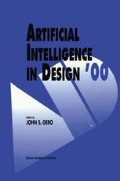Abstract
Although often specifically education-oriented, Case-Based Design systems rarely have become widely used tools in schools of architecture. The primary goal of our study was therefore to explore the effects of using cases in architectural education. Exposing students to examples is not generally applauded by design teachers, as it is thought to increase the danger of design fixation. Only few view cases as a vital basis for creativity. A more specific goal of our study was thus to investigate whether cases either limit or improve creative design solutions. In the study, 2nd year architecture students had to design an entrance hall for an apartment building. Half of them had access to entrance hall projects of previous years, the other half did not. Analysis of students’ designs revealed some interesting effects. In particular, the probability of getting a higher score for the concept, the choice of materials and colors, and the creative character of their project, was positively influenced by exposure to examples. Yet, this positive influence only occurred for the more skilled and motivated students.
Access this chapter
Tax calculation will be finalised at checkout
Purchases are for personal use only
Preview
Unable to display preview. Download preview PDF.
References
Akin, Ö., Cumming, M., Shealey, M. and Tuncer, B.: 1997, An electronic design assistance tool for case-based representation of designs, Automation in Construction, 6, 265–274.
Archer, B.: 1973, Speech at the Design Activity Conference, London.
Barron, F.: 1969, Creativity, Encyclopedia Britannica, vol.6, W. Baton, London, pp. 711–712.
Casakin, H.: 1997, The role of Analogy and Visual Displays, Technion — Israel Institute of Technology, Haifa.
Christiaans, H. and van Andel, J.: 1993, The effects of examples on the use of knowledge in a student design activity: the case of the ‘flying Dutchman, Design Studies, 14(1), 58–74.
Domeshek, E.A and Kolodner, J. L.: 1993, Using the points of large cases, Artificial Intelligence for Engineering Design, Analysis and Manufacturing, 7(2), 87–96.
Domeshek, E.A. and Kolodner, J. L.: 1997, The designer’s muse: Experience to aid conceptual design of complex artifacts, in M. L. Maher and P. Pu(eds.), Issues and Applications of Case-Based Reasoning in Design, Lawrence Erlbaum, London, pp. 11–38.
Flemming, U.: 1994, Artificial intelligence in design: a mid-term review, in G. Carara and Y. E. Kalay (eds.), Knowledge-Based Computer-Aided Architectural Design, Elsevier, Amsterdam, pp. 1–24.
Flemming, U., Aygen, Z., Coyne, R. and Snyder, J.: 1997, Case-based design in a software environment that supports the early phases in building design, in M.L. Maher and P. Pu (eds.), Issues and Applications of Case-Based Reasoning in Design, Lawrence Erlbaum, London, pp. 61–85.
Heylighen, A.: 1998, Exposure to experience. on the role of experience in architectural design education, in Research in Design Education, 1st EAAE-ARCC Conference Proceedings, NC State University, Raleigh, pp., 148–151.
Heylighen, A, Segers, R. and Neuckermans, H.: 1998, Prototype of an interactive case library for architectural design, 4th Design & Decision Support Systems Conference Proceedings, T.U.Eindhoven, Eindhoven, (CD Rom publication).
Hua, K., Faltings, B. and Smith, I.: 1996 CADRE: Case-based geometric design, Artificial Intelligence in Engineering, 10, 171–183.
Koestler, A.: 1989, The Act of Creation, Arkana, London.
Kolodner, J.: 1993, Case-Based Reasoning, Morgan Kaufmann, San Mateo.
Lawson, B.: 1990, How Designers Think, Butherworth Architecture, London.
MacKinnon, D. W.: 1970, Creativity, a multi-faceted phenomenon, in J. D. Rolansky, (ed.), Creativity: A Discussion at the Nobel conference, North Holland, Amsterdam, p. 29.
Maher, M.L, Balachandran, M.B. and Zhang, D.M.: 1995, Case-based Reasoning in Design, Lawrence Erlbaum, Hove.
Moore, K: 1999, How real is visual thinking?, The Architect’s Journal, 29 July, 59–61.
Neuckermans, H. and Geebelen, B. (eds.): 1999, Computers in Design Studio Teaching, EAAE-eCAADe Workshop Proceedings, Transactions on architectural education, No.03, K.U.Leuven, Leuven.
Oxman, R. and Oxman, R.: 1994, Remembrance of things in the past: Design precedents in libraries, in A. Tzonis and I. White, (eds.), Automation Based Creative Design. Research and Perspectives, Elsevier Science, Amsterdam, pp. 55–68.
Papanek, V.: 1984, Design for the Real World, Van Nostrand Reinhold, New York, referred to in (Pollalis, 1994).
Pasman, G. and Hennessey, J.: 1999, Random versus typological organisation of precedents in a design task, Proceedings of the 4th Design Thinking Research Symposium on Design Representation, pp. II. 125-137.
Pollalis S. N.: 1994, Towards the automation of conceptual design, in A. Tzonis and I. White, (eds.), Automation Based Creative Design. Research and Perspectives, Elsevier Science, Amsterdam, pp. 363–428.
Purcell, A. T. and Gero, J. S.: 1996, Design and other types of fixation, Design Studies, 17, 363–383.
Rechtin, E.: 1991, Systems Architecting. Creating & Building Complex Systems, Prentice Hall, London.
Rittel, H.: 1973, Speech at the Design Activity Conference, London.
Rowe, P.: 1982, A priori knowledge in design, Journal of Architectural Education, 36(1), 18–23.
Schank, R. C.: 1982, Dynamic Memory. A Theory of Reminding and Learning in Computers and People, Cambridge University Press, Cambridge.
Schmidt-Belz, B. and Hovestadt, L.: 1996, Scenario for an integrated design support for architects, Design Studies, 17, 489–509.
Smith, I., Stalker, R. and Lottaz, C.: 1996, Creating design objects from cases for interactive spatial composition, in J. S. Gero and F. Sudweeks, (eds.), Artificial Intelligence in Design’ 96, Kluwer Academic, Dordrecht, pp. 97–116.
Author information
Authors and Affiliations
Editor information
Editors and Affiliations
Rights and permissions
Copyright information
© 2000 Springer Science+Business Media Dordrecht
About this chapter
Cite this chapter
Heylighen, A., Verstijnen, I.M. (2000). Exposure To Examples. In: Gero, J.S. (eds) Artificial Intelligence in Design ’00. Springer, Dordrecht. https://doi.org/10.1007/978-94-011-4154-3_21
Download citation
DOI: https://doi.org/10.1007/978-94-011-4154-3_21
Publisher Name: Springer, Dordrecht
Print ISBN: 978-94-010-5811-7
Online ISBN: 978-94-011-4154-3
eBook Packages: Springer Book Archive

